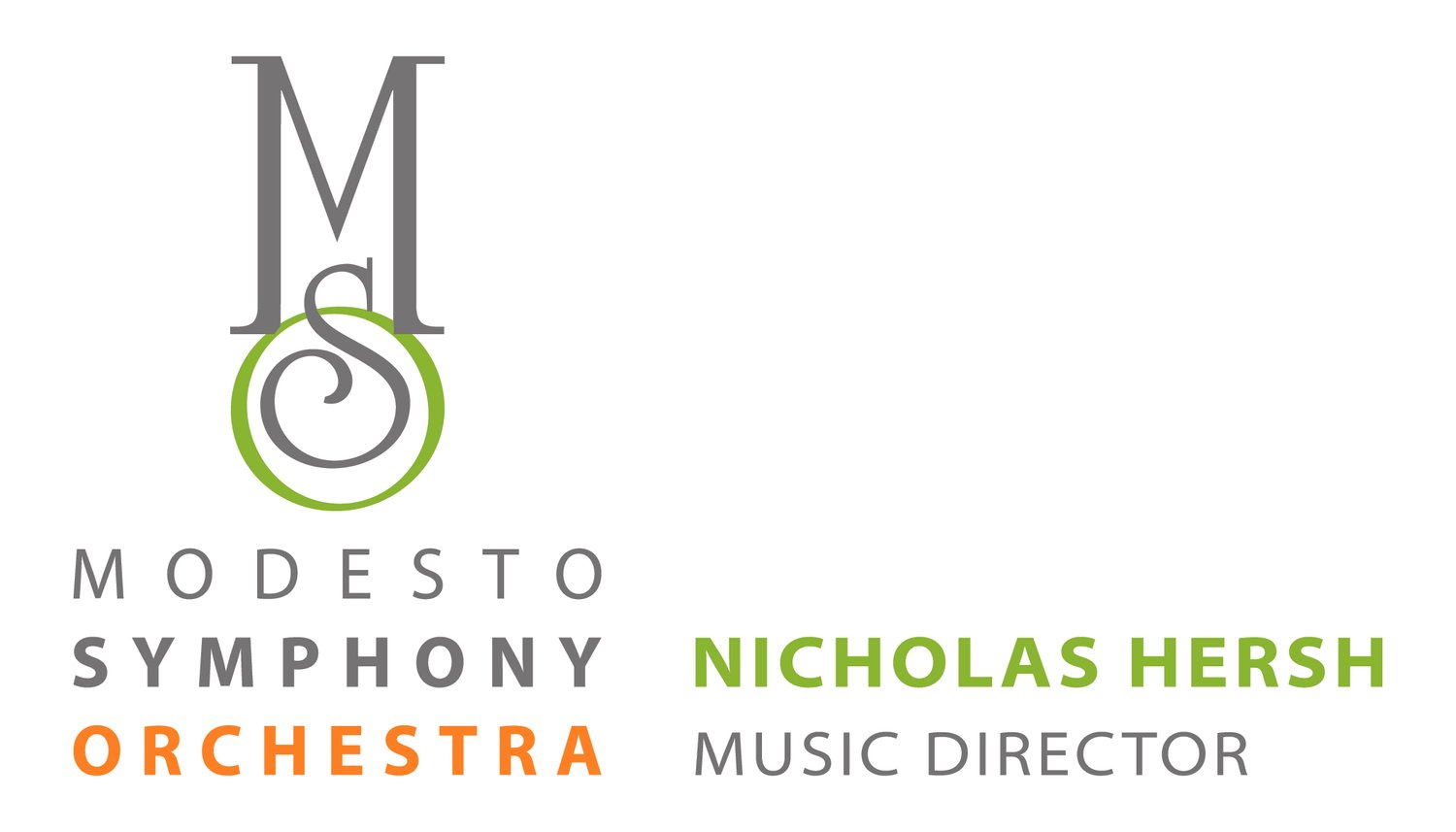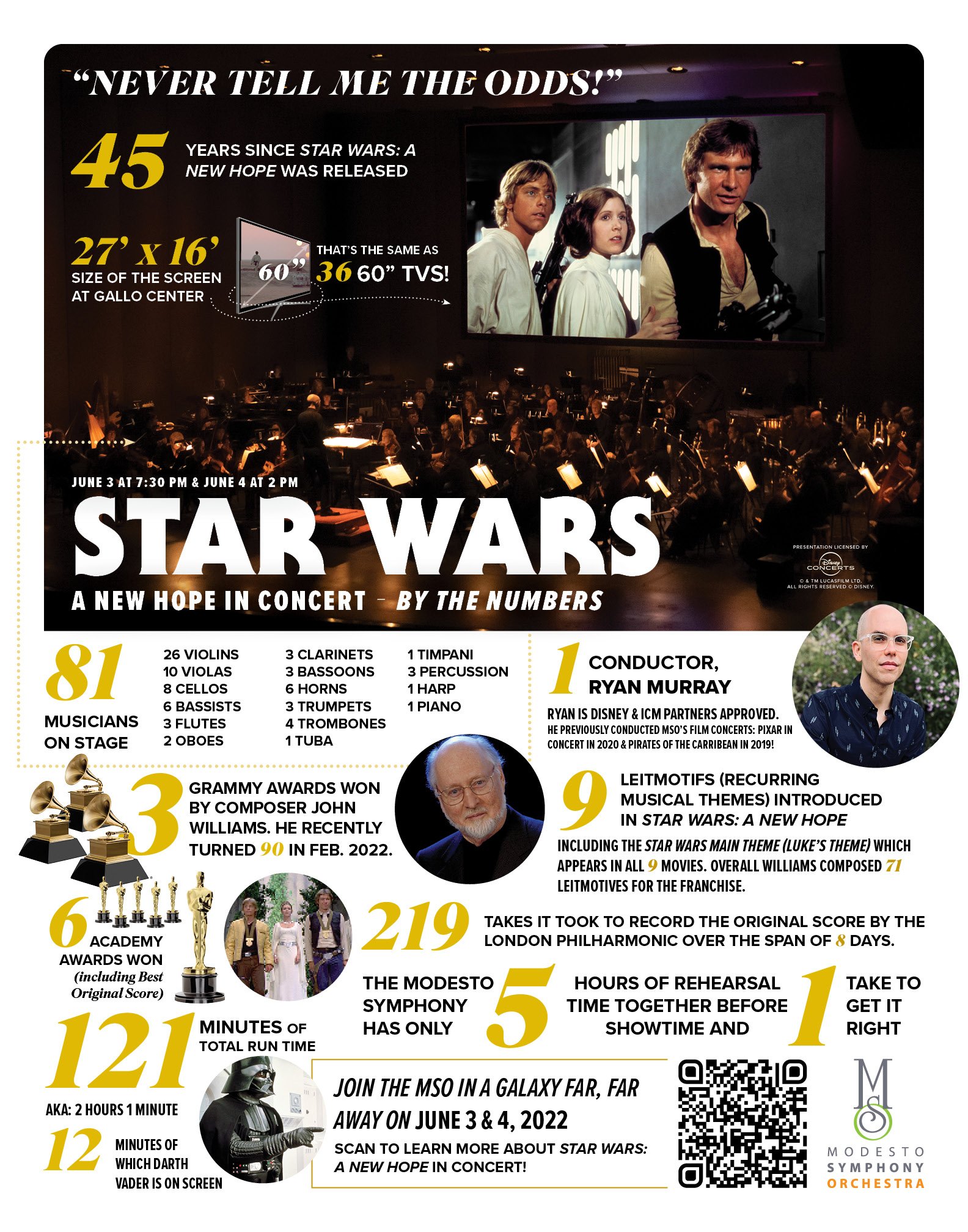Behind the Podium / The force is strong with the mso
This May 31st & June 1st, the Modesto Symphony Orchestra returns to a galaxy far, far away when we perform Star Wars: Return of the Jedi live to film!
Principal Pops Conductor Ryan Murray conducted many of the MSO’s film concerts, including last year’s Star Wars: The Empire A New Hope and in 2022, Star Wars: A New Hope in Concert. This year, he will be leading 84 musicians in perfect time as Star Wars: Return of the Jedi plays on a 26’ x 16’ screen (the equivalent of 36 60” TVs!). An impressive feat that is a result of only 5 total hours of rehearsal time together!
Read on for an exclusive look behind the stage to see what goes into preparing for a unique concert like this with an interview with Ryan Murray we did last May 2023!
MSO: How long does it take for you to prepare for a movie concert and is there any difference compared to preparing for a standard classics or other pops concerts?
Ryan Murray, conductor: It takes anywhere between four to six months to prepare for a movie concert and there are some major differences in how you prepare for these concerts compared to a standard classics or pops concert. The major difference in getting ready for one of these concerts is memorizing and internalizing the tempos of the original movie. Unlike in a traditional concert where the interpretation can vary from orchestra to orchestra and conductor to conductor, in the movie concerts you must play exactly in time with the film! And while I have a special screen in front of me with something called punches and streamers on it to help me line up with the film, the orchestra does not have that information, so it’s my job to really know the score inside and out so that we can make sure everything lines up just right!
Conductor Ryan Murray at the podium, with screen that provides film information in real-time.
MSO: Could you explain the how you use the screen in front of you to help line the orchestra up with what is on the big screen?
RM: Sure, while I’m conducting I have a click track and a special screen in front of me that I use to line everything up with the film. The orchestra does not have that information, so it is really the conductor’s job to make sure that all the tempos line up exactly with the film. Once the movie starts there is no margin for error, and we all must work very hard to make everything match! It is actually a very fun challenge and keeps you on your toes as a conductor!
MSO: Now that you've done a couple Star Wars in Concert performances, what did you learn from that experience and were there any surprises or challenges that come to mind?
RM: I think that the most interesting thing about performing the Star Wars movies in concert is how much freedom you have as a conductor. The score is written in such a symphonic way that you have the room to be slightly flexible with each performance- each performance is unique and exciting! Obviously, there are key moments where you have to make sure everything lines up exactly, but there are other places where you can let the orchestra be a little bit free and that makes for a really incredible musical experience.
MSO: John Williams’ scores are so iconic and each film he works on is distinctive, even when included in a franchise like Star Wars. Are there any differences to the overall musical tone for this movie, The Empire Strikes Back compared to A New Hope?
RM: There are a lot of similarities in the soundtrack including the overall size of the orchestra, the way the music is scored and the iconic opening credits music, but there is a little bit of a darker tone to this movie. The music is a bit more introspective, and I think emotionally a little bit deeper as well. We get introduced to some new characters in this film including Yoda, and the wonderful music that makes up Yoda’s theme. We also see a great character development arch happening with the main players from the first film and the music reflects that beautifully.
MSO: So, who is your favorite character from the franchise and what is your favorite theme to listen to and which is your favorite to conduct?
RM: It would be hard to pick a favorite character from the franchise, probably Yoda or Darth Vader – talk about opposite ends of the spectrum! They both have such great music!
I really enjoy conducting the opening theme – that classic Star Wars melody. The opening ten minutes of every Star Wars movie features the entire orchestra and some really challenging music– it’s always a lot of fun! I always enjoy listening to the Imperial March – there is such intensity to that music – and such great brass writing!
The Force is Strong with the MSO
Come join Ryan Murray & the MSO on a trip to a galaxy far, far away in Star Wars: The Return of the Jedi in Concert this May 31 & June 1 at the Gallo Center for the Arts!
This article was updated May 20, 2024.




































